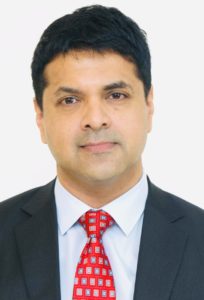The Role of Actuaries in ERM
Lessons from Gavin R. Maistry, FSA, CERA, CFA, FSAS, regional CRO and chief actuary of Munich Re, Singapore
May 2021
FSA, CERA, CFA, FSAS
Photo: iStock.com/eric1513
Traditional actuarial roles are often thought of as pricing, valuation and regulatory reporting in (re)insurance companies and advisory roles in employee benefits. Today, actuaries are making inroads in other areas and industries such as banking, environmental finance, data analytics and enterprise risk management (ERM).
For more about the role of actuaries in ERM, read on and learn from the journey of Gavin R. Maistry, FSA, CERA, CFA, FSAS, regional chief risk officer (CRO) and chief actuary of Munich Re, Singapore. He shares how he began his career as an actuary and progressed into the ERM space.
Education and Career Path
Gavin’s actuarial journey began rather unconventionally. After graduating from the University of Cape Town with degrees in mathematics, mathematical statistics and theoretical physics, he began his career at a South African life insurance company. While working there, a Canadian colleague nudged him toward the Society of Actuaries (SOA) actuarial exams. He recalls receiving an information packet and examination catalog from the SOA in the mail and wondering why the fall exams were scheduled during the Southern Hemisphere’s spring! Gavin ultimately chose to pursue the SOA’s Finance & ERM track, and post-qualification he went on to become a chartered financial analyst (CFA) and charted enterprise risk analyst (CERA) and earned his Ph.D.
In his early career, Gavin’s roles were predominantly in investment and life product development for South African and U.K. insurers. He gradually progressed to chief pricing and chief reserving actuary roles in reinsurance companies in Switzerland and Singapore. This reinsurance experience provided an excellent way to gain rapid exposure to multiple insurance markets and products. Eventually, Gavin made the transition to working in ERM at his current company, Munich Re, when the company established an ERM hub in Singapore. His strong business and risk management knowledge made him a natural choice for the role of regional CRO.
Actuaries in ERM
To be successful in ERM, Gavin believes a thorough understanding of the business and a strong grounding in traditional actuarial roles go a long way. He says a good CRO “should be business enabling and at the same time be promoting proper risk culture throughout the organization. The CRO is a key executive who has a seat at the management table, and the role has much influence and impact across the organization.”
Gavin believes that an actuarial training helps in a risk management role because actuarial training and practice have risk management at their core. To transition into a risk management role and be relevant today, Gavin notes that much of the traditional actuarial tasks are already geared toward risk management. “However, the traditional actuarial terminology, nomenclature and conventions need updating into a new language that takes into account modern risk management concepts and thinking,” he says.
Gavin continues: “In this modern and complex age, actuaries also need to be wary of self-assured hubris and incorporate the views of other experts such as medical doctors, climate scientists and credit specialists/legal experts. In an increasingly complex world, actuaries are expected to work in such multidisciplinary teams and to consolidate and synthesize sometimes-recalcitrant views with their broad underwriting expertise, probabilistic decision-making skills and ability to meld data and models with intuition and judgment. Hence, a key component of risk management decision-making is qualitative judgment in addition to quantitative analytical modeling. In the training of actuaries, great strides have been made on the analytical side. However, the training of judgment, both intuitive and deliberate, has largely been ignored and needs to be given more attention to produce more sagacious risk managers.”
Actuaries Stepping into New Realms
Gavin has observed that in certain countries, like South Africa and Australia, there is currently a surplus of actuaries for traditional roles due to factors like market consolidation and excellent university programs. “In such markets, actuaries have already ventured into nontraditional roles in asset/wealth management and banking with notable success,” he says. “Actuaries are also well-positioned to drive innovations, like insurance securitization, that require both actuarial and finance skills.”
In the last couple of years, International Financial Reporting Standard 17 (IFRS 17) and, more recently, the COVID-19 crisis have opened up the space for actuaries to venture into more nontraditional roles and eventually become chief financial officers (CFOs) or CROs. IFRS 17 places an emphasis on uncertain cash flows, and in a post-COVID-19 world, companies across industries, nongovernmental organizations (NGOs) and even governments will be more focused on a holistic approach to risk management. This is when the wider expertise of senior actuaries makes them ideal candidates to become CFOs, CROs and even CEOs of complex businesses.
Actuaries, ERM and Asia
Having practiced in many roles and many countries around the world, Gavin believes there is still a shortage of actuarial talent in Asian markets, where most actuaries end up in traditional roles. In some Asian markets, however, a property and casualty (P&C) role may be viewed as nontraditional!
ERM in Asian markets is becoming increasingly important. This is driven by stakeholders, like rating agencies, parent companies of multinationals and regulators, adopting similar regimes to Solvency II. Gavin says: “In developed insurance markets like Singapore, Hong Kong, Japan and Korea, the role of the CRO has gained increasing importance in recent years, and it is not uncommon to see an actuary occupying this seat. However, it may take more time before actuaries in Asia venture into nontraditional industries like banking or asset/wealth management.”
Advice for Aspiring Actuaries
For young actuaries who want to venture into risk management, Gavin advises that they should gain a deep understanding of the insurance industry. “Aspiring actuaries need to appreciate that the insurance industry is a fascinating industry to build a career in. The world is increasingly filled with volatility, uncertainty, complexity and ambiguity (VUCA). Actuaries tend to sometimes become too specialized in particular lines of business or even specific products. So, early in your career, rotate through multiple functions, markets, lines of business and countries, and even try a few nontraditional roles,” he says.
To prepare for a risk management role, Gavin says understanding behavioral economics, economics, data analytics and the communication of risk is vital. Programs such as the CERA, CFA or financial risk manager (FRM) may also help. Finally, Gavin says, “A vital trait for risk managers is the constant quest and thirst for learning because risk topics change over time, and we constantly have to sharpen our expertise in many fields.”
Having said that, Gavin is currently enrolled in a program that offers a sustainability and climate change certification for his own professional development. He certainly practices what he preaches.
Statements of fact and opinions expressed herein are those of the individual authors and are not necessarily those of the Society of Actuaries or the respective authors’ employers.
Copyright © 2021 by the Society of Actuaries, Chicago, Illinois.

